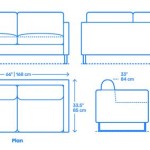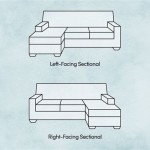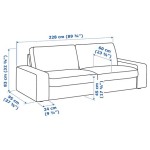Kivik Sofa Bed Assembly and Usage Instructions
The Kivik sofa bed, offered by IKEA, is a popular choice for individuals seeking a versatile and comfortable seating and sleeping solution. It combines the functionality of a sofa with the convenience of a pull-out bed, making it suitable for living rooms, guest rooms, and smaller spaces where maximizing utility is essential. This article provides a comprehensive guide to assembling and utilizing the Kivik sofa bed, ensuring a seamless experience from initial setup to long-term use.
Before commencing the assembly process, it is critical to inventory all components against the parts list included in the packaging. This will help identify any missing or damaged pieces, which can be addressed by contacting IKEA’s customer service. The parts list typically includes the sofa frame components, cushions, legs, hardware (screws, bolts, and Allen keys), and the pull-out bed mechanism. Keeping the packaging organized can also be beneficial for referencing the assembly diagrams.
The assembly instructions provided by IKEA are generally visual and rely on diagrams rather than extensive text. Careful examination of these diagrams is paramount to understanding the correct sequence of steps. Patience and attention to detail are key to avoiding errors and ensuring the structural integrity of the assembled sofa bed.
Step-by-Step Assembly Guide
The assembly process typically begins with constructing the sofa frame. This involves connecting the side panels, back panel, and base using the provided hardware. Ensure that all connections are secure and flush to provide a stable foundation. Use the appropriate Allen key to tighten the screws and bolts adequately, but avoid over-tightening, which can damage the frame.
Next, the pull-out bed mechanism needs to be attached to the frame. This part of the assembly can be slightly more complex and requires careful alignment. The mechanism usually consists of several metal components that need to be bolted together in a specific order. Refer to the diagrams closely to ensure that the mechanism operates smoothly and that the bed platform is properly supported.
Once the frame and bed mechanism are assembled, the legs need to be attached. These typically screw into designated points on the base of the frame. Ensure that all legs are securely fastened to provide even weight distribution and prevent wobbling. Adjust the leg height if necessary to ensure the sofa bed is level.
Finally, the cushions can be placed onto the frame. The seat cushions usually have designated positions and may be secured with Velcro or other fastening mechanisms. The back cushions also need to be properly positioned to provide optimal support and comfort. At this stage, the sofa bed is essentially complete, and its functionality can be tested.
Operating the Pull-Out Bed Mechanism
The Kivik sofa bed's pull-out mechanism is designed for ease of use, but understanding the correct procedure is important to prevent damage and ensure longevity. Locate the designated handles or straps, typically located under the seat cushions. Grasp these firmly and pull outwards to extend the bed platform.
Depending on the specific model, the bed platform may unfold in one or two sections. Ensure that all sections are fully extended and locked into place before applying weight. Some models may have locking mechanisms that need to be engaged to prevent the bed from retracting unintentionally. Refer to the product manual for specific instructions regarding the locking mechanism.
When converting the sofa bed back into its sofa configuration, reverse the process. Release any locking mechanisms, if present, and gently fold the bed platform back into the frame. Ensure that all sections are properly aligned and secured before replacing the seat cushions. Avoid forcing the mechanism if it encounters resistance; instead, check for any obstructions and ensure that all components are properly aligned.
Care and Maintenance for Longevity
Proper care and maintenance are crucial for extending the lifespan of the Kivik sofa bed and preserving its aesthetic appeal. Regular cleaning is essential to prevent the accumulation of dirt, dust, and stains. Vacuum the upholstery regularly using a brush attachment to remove loose particles. For spills and stains, act promptly to prevent them from setting in. Blot the affected area with a clean, absorbent cloth and avoid rubbing, which can spread the stain. Use a mild detergent solution specifically designed for upholstery cleaning, following the manufacturer's instructions.
The Kivik sofa bed features removable and washable cushion covers. Regularly washing these covers helps maintain their cleanliness and freshness. Before washing, consult the care label on each cover to determine the appropriate washing instructions. Some covers may be machine washable, while others may require dry cleaning. Avoid using harsh detergents or bleach, as these can damage the fabric. After washing, allow the covers to air dry completely before replacing them on the cushions.
Periodically inspect the frame, bed mechanism, and legs for any signs of wear and tear. Tighten any loose screws or bolts to maintain the structural integrity of the sofa bed. Lubricate the bed mechanism with a silicone-based lubricant to ensure smooth operation. Address any minor repairs promptly to prevent them from escalating into more significant problems.
Protect the sofa bed from direct sunlight and excessive heat, as these can cause the fabric to fade and deteriorate. Consider using a sofa cover to protect the upholstery from stains, pet hair, and other potential damage. Rotate the cushions regularly to ensure even wear and prevent them from becoming flattened in certain areas. With proper care and maintenance, the Kivik sofa bed can provide years of comfortable seating and sleeping accommodation.
Troubleshooting Common Issues
Despite careful assembly and maintenance, users may occasionally encounter issues with their Kivik sofa bed. Some common problems include difficulty extending or retracting the bed mechanism, squeaking noises, and instability. Addressing these issues promptly can prevent them from worsening and ensure the continued functionality of the sofa bed.
If the bed mechanism is difficult to extend or retract, check for any obstructions that may be hindering its movement. Ensure that all locking mechanisms are properly disengaged and that the platform is aligned correctly. Lubricate the moving parts with a silicone-based lubricant to reduce friction and improve smoothness. If the problem persists, consult the IKEA customer service for assistance.
Squeaking noises can often be attributed to loose screws or bolts in the frame or bed mechanism. Tighten all connections to eliminate any play and reduce friction. If the squeaking continues, try applying a small amount of lubricant to the joints and hinges. Ensure that the sofa bed is placed on a level surface to prevent uneven weight distribution, which can also contribute to squeaking noises.
Instability can be caused by loose legs or an uneven floor. Ensure that all legs are securely fastened and that they are all making contact with the floor. Adjust the leg height if necessary to level the sofa bed. If the floor is uneven, consider using shims to provide additional support and stability.
By following these assembly, usage, and maintenance guidelines, individuals can maximize the functionality and longevity of their Kivik sofa bed, creating a comfortable and versatile living space.

Kivik Sofa Unboxing Assembling How To

How To Put Together The Kivik Couch Step By Assemble Guide With Pictures Of Manual

Kivik Sofa Assembly Timelapse

Kivik 3 Seat Sofa Bed Cover Slipcover Hand Made Multiple Color Hong Kong

How To Put Together The Kivik Couch Step By Assemble Guide With Pictures Of Manual

Kivik Sofa Bed Cover Bemz

Kivik Sofa Bed Cover Comfort Works

My Kivik Sofa Review After 3 Years Love Renovations

Kivik Sofa Tibbleby Instructions

Ers Help Can I Make Slimmer Kivik Armrests








